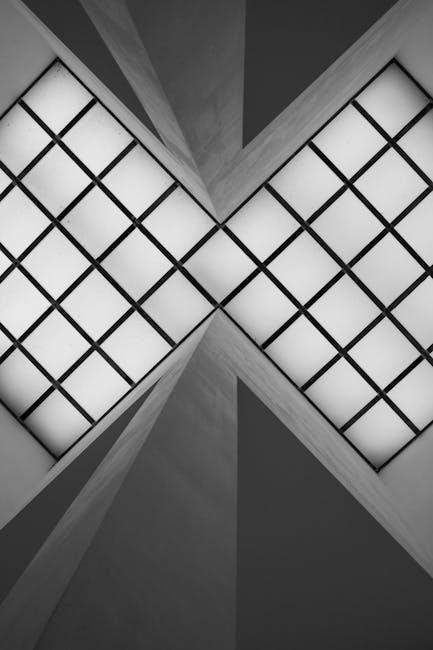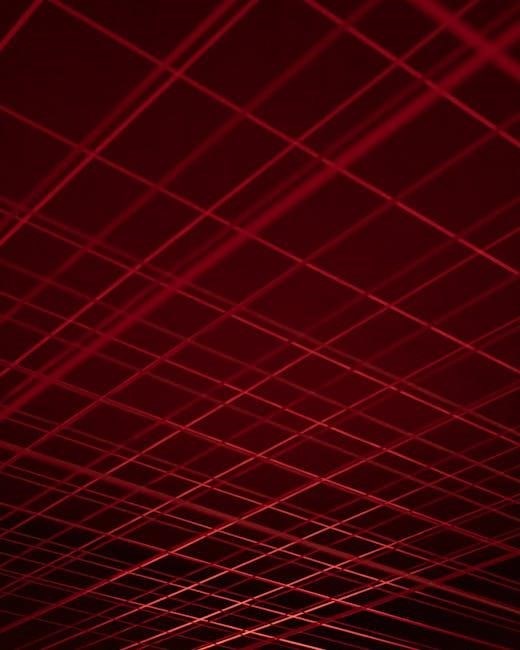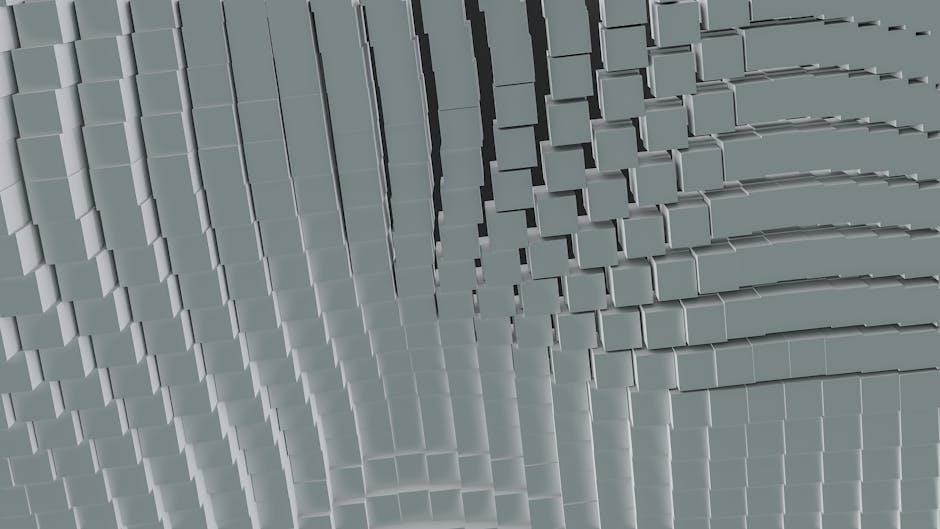Grid systems are foundational tools in graphic design, enabling structured layouts․ Josef Müller-Brockmann’s seminal work, Grid Systems in Graphic Design, explores their application, offering practical examples and theoretical insights․ This PDF resource remains essential for understanding grid principles, providing a visual communication manual for designers seeking coherence and balance in their work․
1․1 Definition and Purpose of Grid Systems
A grid system is a structured framework used to organize content coherently․ It consists of horizontal and vertical guides that divide a space into columns and rows, ensuring alignment and consistency․ Primarily, grids serve to enhance readability, balance, and visual flow in designs․ They act as a foundation for arranging typography, images, and other elements, making communication clearer and more professional․ Grids are essential for creating systematic yet flexible layouts in graphic design․
1;2 Historical Background and Evolution
Grid systems trace their origins to early printing and typography, where alignment and structure were crucial․ The Industrial Revolution brought standardization, influencing grid use in publishing․ Modernist movements of the 20th century, led by designers like Josef Müller-Brockmann, popularized grids as tools for clarity and order․ Over time, grids evolved from rigid systems to flexible frameworks, adapting to digital design and diverse creative needs while maintaining their core purpose of organizing visual content effectively and harmoniously․

Benefits of Grid Systems in Graphic Design
Grid systems enhance efficiency and consistency in design, ensuring alignment and balance․ They streamline workflows, allowing designers to focus on creativity while maintaining a cohesive visual structure․
2․1 Visual Coherence and Order
Grid systems establish visual coherence by organizing elements systematically․ This structure ensures consistency, making designs more professional and easier to navigate․ Josef Müller-Brockmann’s work highlights how grids align text, images, and other components harmoniously, creating a balanced layout that enhances readability and aesthetic appeal․
2․2 Flexibility and Consistency in Layouts
Grid systems offer flexibility while maintaining consistency, allowing designers to adapt layouts to various content types․ By adjusting spacing, columns, and alignment, grids enable creative freedom within a structured framework․ This balance ensures designs remain cohesive and professional, whether applied to single pages or multi-page documents, enhancing readability and user experience across different projects․

Construction of Grid Systems
Grid systems are constructed using modular frameworks to organize content․ Josef Müller-Brockmann’s Grid Systems in Graphic Design details their creation, emphasizing alignment and spacing for balanced, functional designs․ These structured layouts enhance visual communication, making them indispensable in modern graphic design․ The PDF resource provides practical examples and theoretical insights into building effective grids․
3․1 Types of Grids (Modular, Hierarchical, etc․)
Grid systems vary in type, with modular grids offering consistent column widths for structured layouts․ Hierarchical grids prioritize content flow, guiding the viewer’s eye․ Müller-Brockmann’s Grid Systems in Graphic Design PDF details these grid types, emphasizing their role in organizing visual elements․ Modular grids ensure uniformity, while hierarchical grids create dynamic compositions․ Understanding these types enables designers to select the most suitable grid for their creative goals, enhancing both functionality and aesthetic appeal in graphic design projects․
3․2 Principles of Grid Construction
Grid construction relies on defining columns, rows, and margins to create a consistent framework․ Müller-Brockmann’s Grid Systems in Graphic Design PDF outlines these principles, emphasizing balance and alignment․ The grid acts as a guide for placing elements, ensuring harmony and readability․ By establishing a clear structure, grids allow designers to organize content effectively while maintaining visual appeal, making them a cornerstone of professional graphic design practices․

Grid Systems in Digital Tools
Grid systems are seamlessly integrated into digital tools like Adobe InDesign, offering precise control over layouts․ Josef Müller-Brockmann’s Grid Systems in Graphic Design PDF serves as a valuable guide for leveraging these features in modern design workflows, ensuring alignment and consistency across digital projects․
4․1 Adobe InDesign and Grid Functionality
Adobe InDesign offers robust grid functionality, enabling precise layout control․ Josef Müller-Brockmann’s Grid Systems in Graphic Design PDF aligns with InDesign’s tools, such as the grid tool, snap-to-grid, and baseline grids․ These features allow designers to create structured, aligned designs efficiently․ InDesign’s grid systems support complex layouts, ensuring typographic hierarchy and spatial balance, making it a powerful tool for implementing Müller-Brockmann’s grid principles in modern graphic design workflows․
4․2 Other Design Software Supporting Grids
Beyond InDesign, tools like Figma, Sketch, and Adobe Illustrator support grid systems․ Josef Müller-Brockmann’s Grid Systems in Graphic Design PDF provides principles applicable across these platforms․ Figma’s grid and layout features, Sketch’s smart guides, and Illustrator’s artboards facilitate precise alignment and consistency․ These tools empower designers to implement grid-based designs, aligning with Müller-Brockmann’s theories for creating visually coherent and professional layouts in various digital environments․

Case Studies and Examples
Josef Müller-Brockmann’s work showcases grid systems in practice, particularly his iconic Musica Viva posters․ His Grid Systems in Graphic Design PDF highlights these examples, demonstrating how grids create visual harmony and structure in real-world applications․
5․1 Josef Müller-Brockmann’s Work
Josef Müller-Brockmann, a pioneer in graphic design, revolutionized the use of grid systems through his work․ His iconic Musica Viva posters exemplify how grids create visual order and harmony․ In his book Grid Systems in Graphic Design, he detailed practical applications, showcasing grids as tools for clarity and structure․ His work remains a cornerstone of modern design, inspiring designers to leverage grids for effective visual communication and aesthetic balance․
5․2 Modern Applications in Graphic Design
Grid systems remain integral to modern graphic design, aiding in creating structured, responsive layouts․ Designers use grids in digital tools like Adobe InDesign and Figma to ensure alignment and consistency․ Modern applications include web design, where grids facilitate responsive layouts, and branding, where they help maintain visual identity․ Grids also enhance readability in complex compositions, proving their versatility in balancing creativity with order in contemporary design practices․

Layout and Composition Principles
Effective layout and composition rely on balance, hierarchy, and negative space․ Grid systems guide these principles, ensuring visual harmony and clear communication in graphic design projects․
6․1 Balancing Content and Negative Space
Balancing content and negative space is crucial for visual harmony․ Grid systems help distribute elements evenly, ensuring neither overcrowding nor emptiness․ This balance enhances readability and aesthetic appeal, guiding the viewer’s eye effectively․ By structuring layouts with intentional spacing, designers create compositions that are both functional and visually engaging, as highlighted in Grid Systems in Graphic Design by Josef Müller-Brockmann․
6․2 Aligning Elements for Better Readability
Aligning elements within a grid enhances readability by creating a clear visual flow․ Proper alignment ensures text and images are easily navigable, reducing cognitive strain․ Josef Müller-Brockmann’s Grid Systems in Graphic Design emphasizes how precise alignment fosters consistency, making designs more professional and user-friendly․ This principle is essential for effective communication in both print and digital media, as outlined in the PDF resource․
Typography in Grid Systems
Typography plays a crucial role in grid-based designs, enhancing readability and visual structure․ Josef Müller-Brockmann’s work, as detailed in the PDF, highlights how grids integrate seamlessly with type to create balanced compositions․
7․1 Role of Typography in Grid-Based Designs
Typography in grid-based designs ensures clarity and hierarchy, guiding the viewer’s eye through content․ As explored in Grid Systems in Graphic Design PDF, type aligns with grids to enhance readability, creating a cohesive visual structure․ Müller-Brockmann emphasizes how typography within grids establishes a clear communication path, making designs both functional and aesthetically pleasing․ This integration is vital for effective visual storytelling and user engagement in modern graphic design practices․
7․2 Best Practices for Typographic Hierarchy
Establishing a clear typographic hierarchy is crucial in grid-based designs․ Use size, color, and placement to guide the viewer’s eye․ Align text with grid lines for consistency and readability․ Contrast between font sizes and weights helps differentiate content levels․ Proper spacing and alignment ensure a balanced layout․ Müller-Brockmann’s Grid Systems in Graphic Design PDF underscores the importance of hierarchy in creating a logical visual flow, enhancing user engagement and comprehension in designs․
Grid Systems in Three-Dimensional Design
Grid systems extend beyond 2D, influencing three-dimensional spaces․ Müller-Brockmann’s Grid Systems in Graphic Design PDF highlights their application in exhibition and spatial design, creating structured, immersive environments․
8․1 Extending Grid Systems Beyond 2D
Grid systems transition seamlessly from 2D to 3D, providing structural frameworks for spatial designs․ As explored in Grid Systems in Graphic Design PDF, these systems aid in creating immersive environments by aligning architectural elements․ This extension allows for cohesive design across dimensions, ensuring visual harmony in exhibitions and installations․ The application of grids in 3D spaces enhances functionality and aesthetic appeal, proving their versatility beyond traditional graphic design․
8․2 Applications in Exhibition and Spatial Design
Grid systems play a crucial role in exhibition and spatial design by creating immersive environments․ They provide structural frameworks for aligning signage, displays, and lighting, ensuring a cohesive experience․ As detailed in the Grid Systems in Graphic Design PDF, grids enhance spatial organization, guiding visitor flow and emphasizing key elements․ This application extends the traditional use of grids, demonstrating their versatility in three-dimensional spaces and their ability to elevate the functionality and aesthetics of exhibitions and installations․

Resources and Further Reading
Josef Müller-Brockmann’s Grid Systems in Graphic Design PDF is a seminal resource․ Available on Scribd, it offers detailed insights into grid applications, making it indispensable for designers seeking to master grid-based layouts and visual communication principles․
9․1 Recommended Books on Grid Systems
Grid Systems in Graphic Design by Josef Müller-Brockmann is a foundational text․ Available as a PDF, it details grid types, construction, and applications, making it essential for understanding grid systems․ This seminal work is a must-have for designers aiming to master structured layouts and visual communication, offering practical examples and theoretical insights that remain relevant in both digital and print design environments․
9․2 Online Tutorials and Guides
Online resources like Scribd and PDF platforms offer free access to Grid Systems in Graphic Design by Josef Müller-Brockmann․ Additionally, tutorials on YouTube and design blogs provide step-by-step guides for implementing grids in software like Adobe InDesign․ These resources are invaluable for designers seeking to master grid-based layouts, offering practical examples and tips for creating visually coherent designs․ They complement the theoretical foundation with hands-on learning opportunities․
